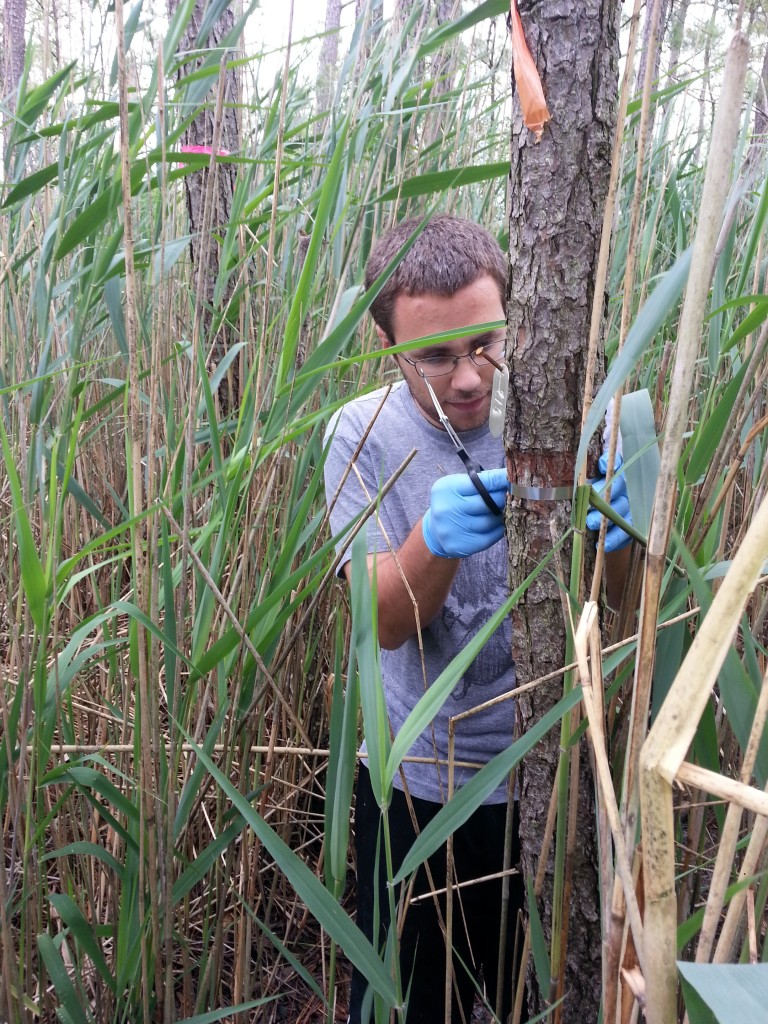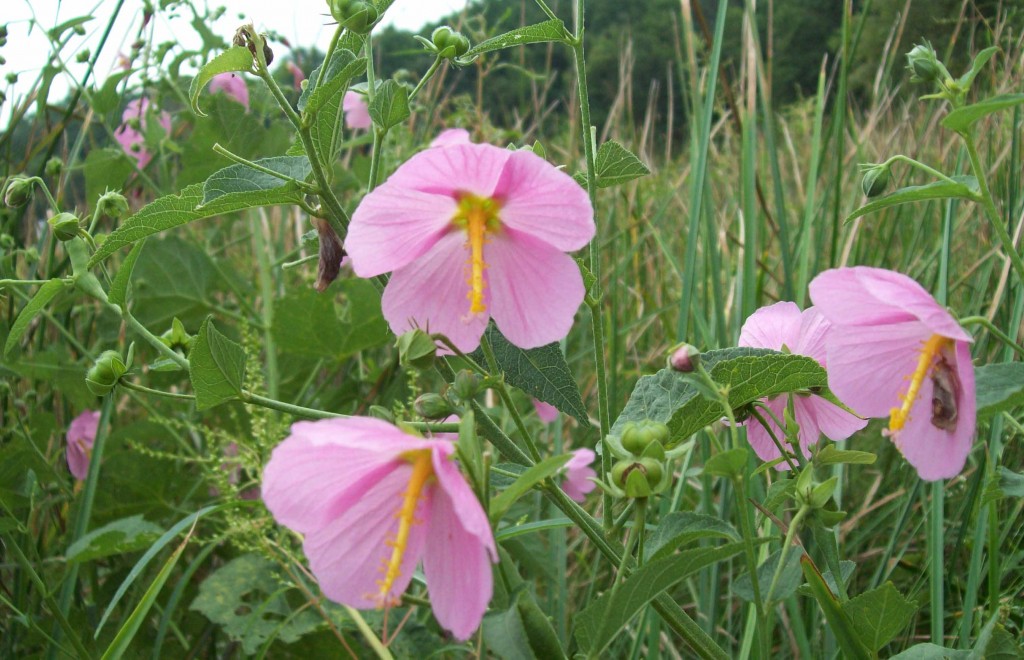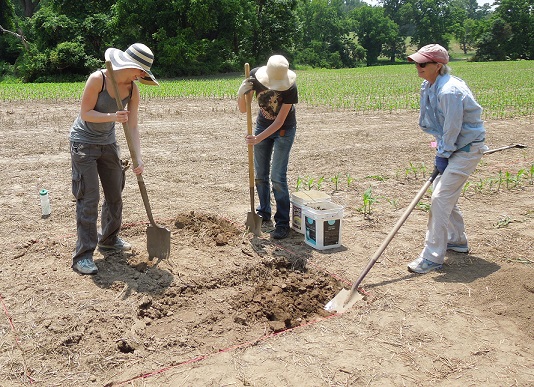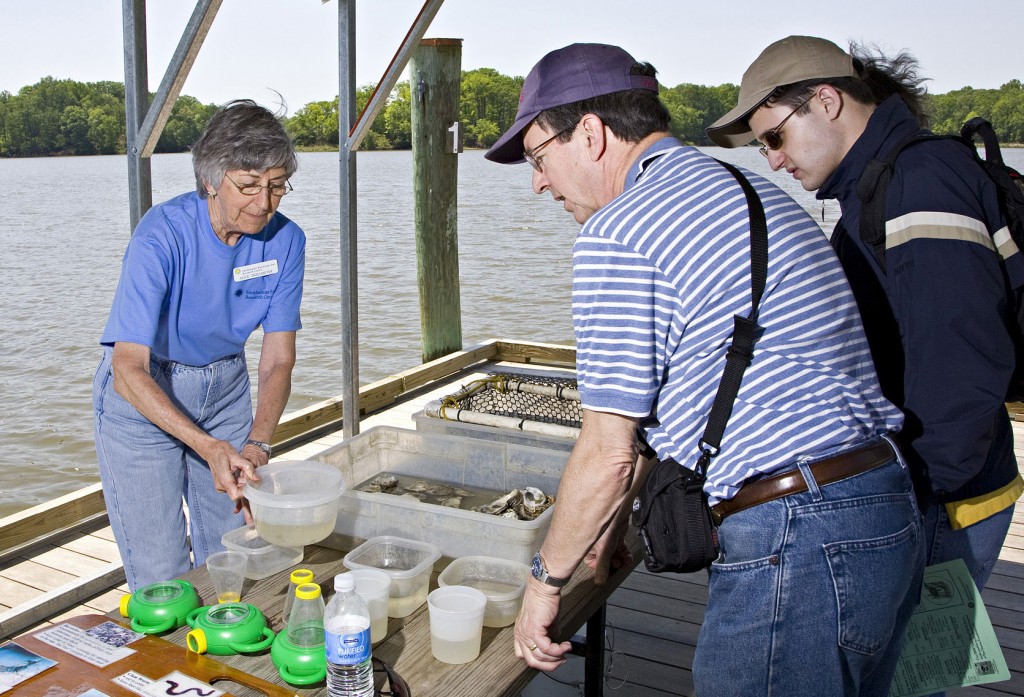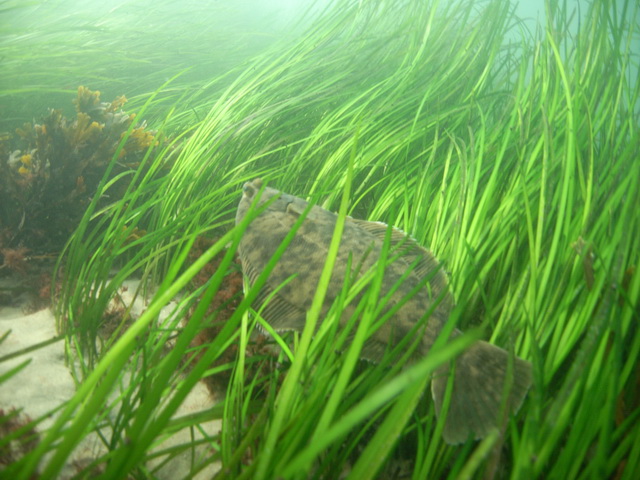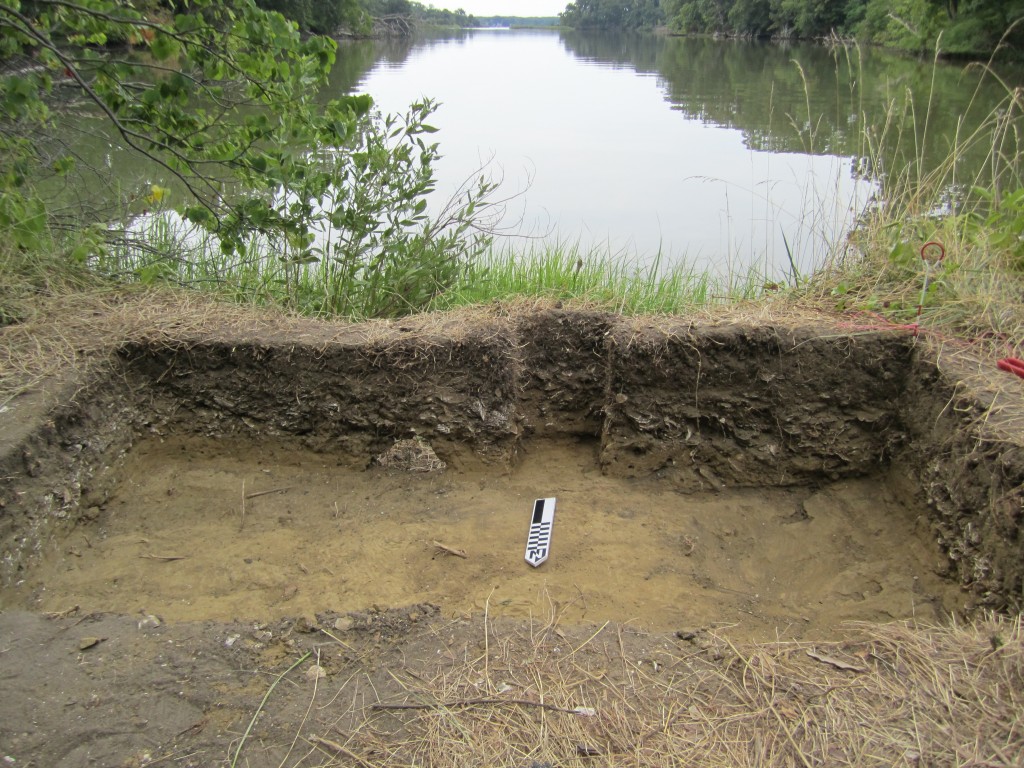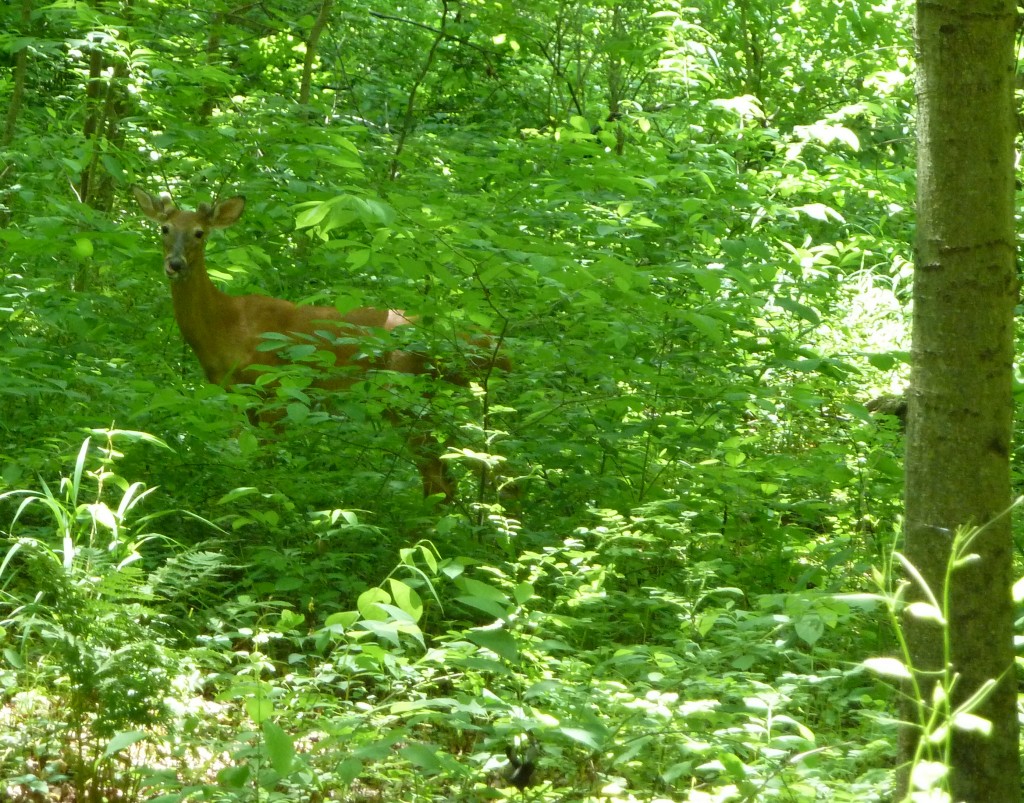Posted by Kristen Goodhue on June 12th, 2014
Citizen scientists brave dense swamps to find truth behind Phrag
By Sarah Hansen

Jack Hays bands a tree in the marsh.
Sea-level rise triggered by climate change affects coastal ecosystems first. Marshes and wetlands along the shoreline creep inland, infringing on forest habitats. Scientists have strong evidence that too much water will gradually drown the trees. But an invasive reedy plant, known as “Phrag” from its scientific name, Phragmites australis, might be the forests’ unlikely protector, delaying drowning by about a decade.
Invasive Phrag (there is a native subspecies, as well) first came to the U.S. from Europe over 200 years ago. The native variety coexists peacefully with other plants, but the invader takes over a habitat, choking off other flora. Only recently, however, has its population growth exploded. Scientists at the Smithsonian Environmental Research Center are trying to find out whether large Phrag populations in wetlands help or hurt tree growth. It might seem counterintuitive, but scientists hypothesize that the Phrag is actually helping trees survive as sea level rises. By removing some of the water, Phrag may prevent trees from drowning. Click to continue »
Posted in Climate Change, Ecology, Invasive Species, Publications | 1 Response »
Posted by Kristen Goodhue on June 11th, 2014
by Kristen Minogue

Swamp Rose Mallow with blades of Schoenoplectus americanus, a sedge in Drake’s marsh experiment. (SERC)
Plants are among the world’s best carbon sinks, but there’s a side to the plant-CO2 love affair that’s rarely discussed. When carbon dioxide rises, plants cling to it more, releasing less back into the air—and until recently, scientists couldn’t figure out why. With a new paper published June 11 in Global Change Biology, ecologist Bert Drake believes he finally has the answer.
The process is called respiration, and it’s one of the most overlooked parts of the carbon cycle. Unlike photosynthesis, in which plants absorb carbon dioxide and release oxygen, respiration reverses it. And plants respire constantly. Much of the CO2 plants take from the atmosphere for photosynthesis finds its way back via respiration from plants and soil. Which leaves a major question: How much carbon can the world’s ecosystems store as CO2 rises and climate changes?
Click to continue »
Posted in Climate Change, Ecology, Publications, SERC Sites and Scenes | Comments Off on The Strange, Controversial Way Plants Trap CO2
Posted by Kristen Goodhue on June 10th, 2014
Scientists, students, and volunteers unearth late 17th– and 18th-century objects behind Sellman House
by Sarah Hansen

Volunteers excavate a new pit at the “Shaw’s Folly” site behind Sellman House.
On a sunny June afternoon at the Smithsonian Environmental Research Center, students and volunteers are hard at work in a cornfield behind the Sellman House. Some shovel soil out of pits. Others screen it with giant sieves, looking for artifacts. Still others use trowels to smooth the bottom and sides of the pit, hoping to reveal differences in soil coloration and texture. This scene will repeat every Monday, Tuesday, and Friday from about 9a.m. to 4 p.m. until June 20. Guided by Laura Cripps, acting Chair of Social and Cultural Sciences at Howard Community College, and Jim Gibb, head of SERC’s Archaeology Lab, the group is excavating a site that contains objects and building materials that provide a window into 17th– and 18th-century life.
Click to continue »
Posted in Archaeology, Land Use, Publications, SERC Sites and Scenes | 1 Response »
Tags: archeology, citizen science, volunteers
Posted by Kristen Goodhue on May 28th, 2014
by Kristen Minogue

Arctic sea ice (Patrick Kelley/U.S. Coast Guard)
For the first time in roughly 2 million years, melting Arctic sea ice is connecting the north Pacific and north Atlantic oceans. The new sea routes leave both coasts and Arctic waters vulnerable to a large wave of invasive species—a problem the Arctic has largely avoided until now.
Click to continue »
Posted in Alaska, Climate Change, Ecology, Invasive Species, Publications | 1 Response »
Posted by Kristen Goodhue on May 8th, 2014
by Kristen Minogue

Veteran volunteer Alice Dollmeyer (left) teaches visitors about oysters at SERC’s annual Open House. (Smithsonian)
After 23 years volunteering outside, Alice Dollmeyer has seen some filthy things. The dirtiest thing she remembers handling at SERC is an oyster basket pulled up from the docks. When she first began, the oyster trays didn’t hang but sat on the bottom of the Rhode River, and would often come up covered in black mud.
Since then Dollmeyer has done just about every education job a SERC volunteer can do. She has lead canoe trips, helped children pick up crabs and run all five stations of the Estuary Chesapeake program for visiting schools. She’s also shown up for every docent workday, a day of housekeeping which, as education specialist Jane Holly describes it, “You get your arms as dirty as possible cleaning up everything to get ready for the field season.”
Click to continue »
Posted in Classes and Events, SERC Sites and Scenes | 1 Response »
Posted by Kristen Goodhue on May 5th, 2014
by Kristen Minogue

A flounder in a bed of eelgrass. Seagrasses and other underwater plants provide food and shelter to many iconic Bay creatures, including blue crabs. (NOAA)
It’s been a difficult century for the submerged flora of Chesapeake Bay.
In the 1930s, wasting disease nearly wiped out the eelgrasses of the North Atlantic. In the ‘50s and ‘60s, they faced onslaughts from invasive grasses like water chestnut and Eurasian milfoil. Finally, in the summer of 1972, Hurricane Agnes pummeled underwater plants to the lowest levels ever reported in the Bay. This April, they received news that, at first glance, seemed positive: Submerged grasses rose 24 percent between 2012 and 2013, according to aerial surveys of the Chesapeake Bay Program.
But those increases were largely limited to a single species: widgeon grass, a plant known for wild fluctuations. At 60,000 acres total, submerged plants still didn’t come near a recent mini-peak in 2002, they’re a far cry from the ultimate goal of 185,000 acres across the Bay. What is holding them back? And—more importantly—how we can we help ensure the latest expansion isn’t just a blip?
Click to continue »
Posted in Land Use, Publications, Water Quality | Comments Off on What’s Hurting the Chesapeake’s Underwater Plants?
Posted by Kristen Goodhue on April 30th, 2014
by Kristen Minogue

An open pit exposes a 3200-year-old shell midden. Native Americans used middens as trash piles for oyster shells, animal bones and pottery. (Torben Rick/Smithsonian)
More than 3,000 years ago, Native Americans dined on shellfish from the Chesapeake Bay, and the leftovers from those feasts are still benefiting modern-day forests.
Native Americans inhabited the Chesapeake Bay area more than 13,000 years before the first Europeans dropped anchor. During the Woodland period (3,200 to 400 years ago), they ate eastern oysters and threw the shells, along with animal bones, pottery and other shellfish remains, into trash piles called shell middens. Those piles enriched the soil with nutrients, promoting hot spots of native diversity along the Chesapeake shoreline.
Click to continue »
Posted in Ecology, Land Use, Publications, SERC Sites and Scenes | Comments Off on Ancient Native American Compost Still Enriching Forests
Posted by Kristen Goodhue on April 29th, 2014
by Kristen Minogue

Three nonnative flowers in Maryland. Left to right: Queen Anne’s Lace, Moth Mullein and Lesser Celandine. (Susan Cook-Patton)
“I just want to plant something that will grow in my yard. If a nonnative species grows better than a native, why shouldn’t I plant it?”
It’s a valid question, one that SERC postdoc Susan Cook-Patton remembers hearing from her father while still in high school. In the quest to preserve native plants, it’s become almost taboo to talk about the benefits of nonnatives. But not all nonnative plants are rampant invaders, and sometimes they could be good for gardens as a whole. Cook-Patton broke down the pros and cons of gardening with nonnative species at the Smithsonian Environmental Research Center’s first evening lecture on April 15. Here are a few to consider when deciding what to put in your garden:
Click to continue »
Posted in Classes and Events, Ecology, Invasive Species, Land Use, Programs, SERC Sites and Scenes | 1 Response »
Posted by Kristen Goodhue on April 24th, 2014
by Kristen Minogue

Jim Carlton tracked invasive species in the ocean for years when most scientists thought the sea was “invasion-proof.” (Anna Sawin)
There’s no official “father of marine invasions biology.” But if anyone could compete for the title, Jim Carlton, director of the Williams College – Mystic Seaport Program, would almost certainly top the list. More than 50 scientists from the U.S., Canada, Italy, Argentina and New Zealand voiced some version of that view, when they descended on the Smithsonian Environmental Research Center for a three-day symposium in April informally dubbed “Jimfest.”
Like so much in science, his career began by sheer accident. In 1962, 14-year-old Carlton stepped on a strange worm while picnicking with his family in Lake Merritt, a small lagoon near San Francisco Bay. A few weeks later he discovered the same worm in an exhibit at a local nature center. The label identified it as a tubeworm from the South Seas. “This thing in my backyard as it were, not far from my house, in this estuarine lagoon, how could this thing be from the South Seas?” Carlton remembered thinking. “So I got fascinated by that concept.”
Click to continue »
Posted in Classes and Events, Invasive Species, Programs, SERC Sites and Scenes | 1 Response »
Posted by Kristen Goodhue on April 8th, 2014
by Kristen Minogue and John Parker

White-tailed deer. (John Parker/SERC)
In deer-populated forests, tastier plants can avoid being eaten if they are surrounded by less appealing plants. But with deer gone, diverse plots become weaker and plants are better off sticking to their own kind.
Click to continue »
Posted in Ecology, Publications, SERC Sites and Scenes | Comments Off on Diversity Helps Forests Resist Deer

